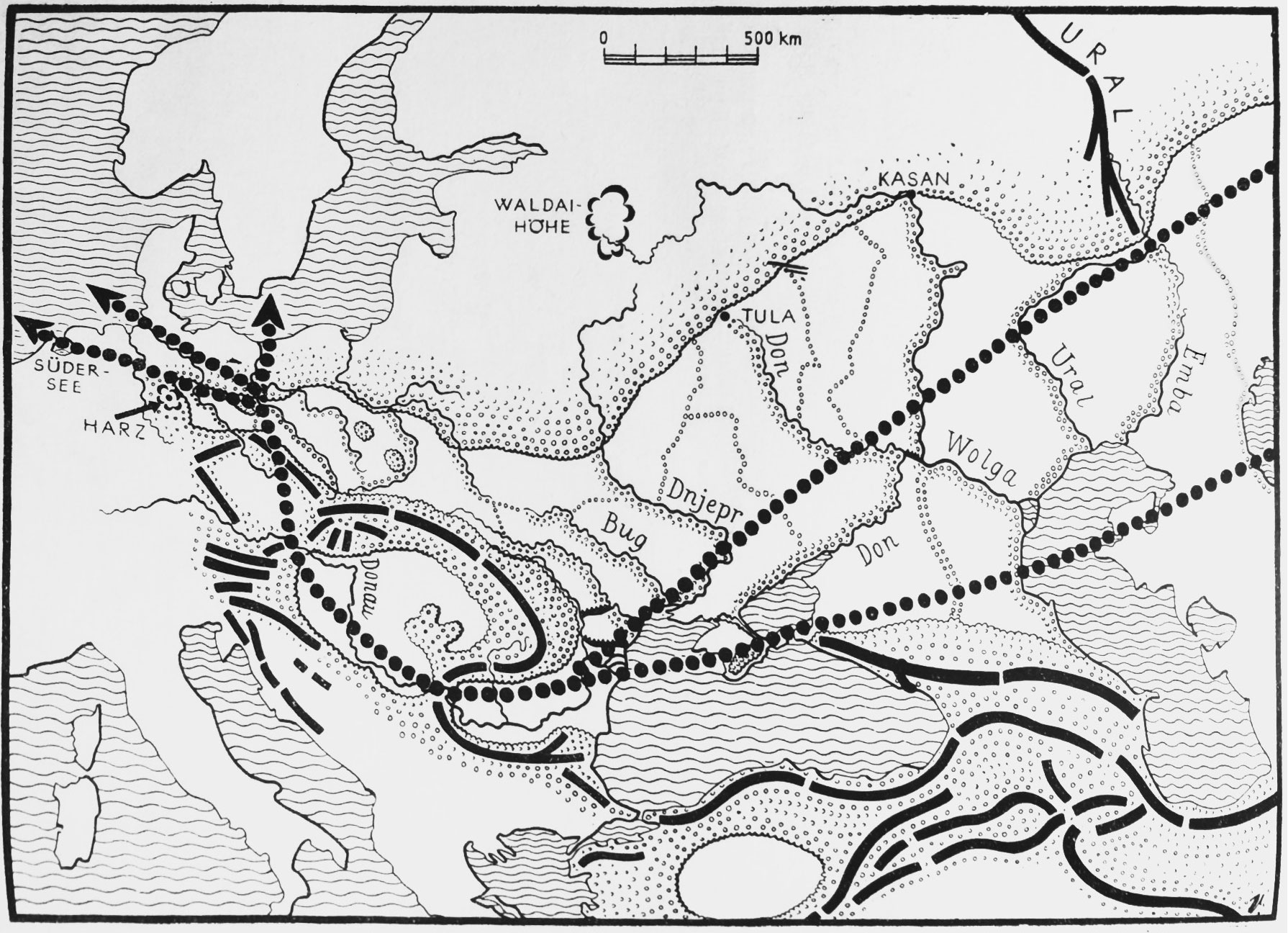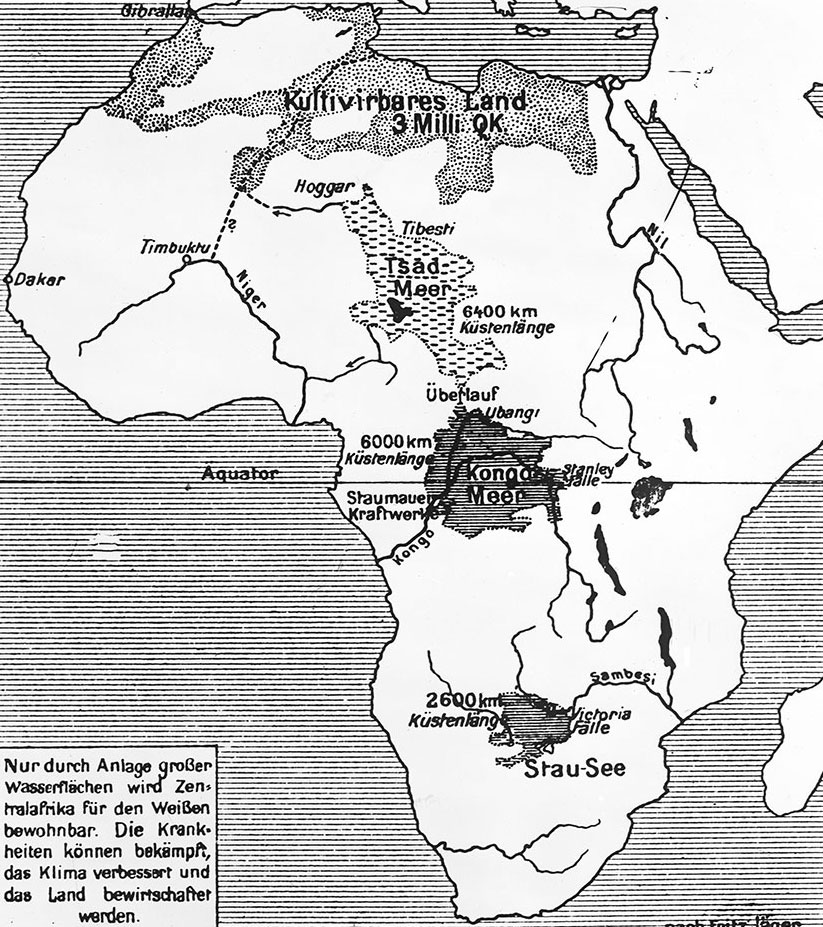Introduction
 In the second half of the nineteenth century, popular science publications and magazines treated their readers to a continuous stream of reports by European travelers. These accounts told heroic stories about the adventurous feats of white men, but usually also provided some information on the inhabitants and environmental conditions of faraway places. Reports about Sahara travels habitually closed with references to a once lush landscape that had turned into a barren wasteland through desertification processes that were possibly still at work. The theory, and the resulting apprehensions among Europeans, that formerly fertile or habitable land could have transformed into desert was not only a standard ingredient of exploration stories but closely linked to the scholarly study of climates. As an independent academic discipline, climatology was still a field in the making, but had already reached a sizeable audience and achieved a sturdy academic infrastructure. With a motley crew of practitioners from various related fields, climatology also featured a diverse set of approaches and methodologies, borrowing from geology, physics, and chemistry. More often than not, however, nineteenth-century climatic researchers relied on historic and geographic data to make inferences about climatic phenomena. While the methods they used were clearly different from the model-driven and computer-based climate science of today, one of the most important objects of investigation – climatic variation in the past, present, and future – was the same.
In the second half of the nineteenth century, popular science publications and magazines treated their readers to a continuous stream of reports by European travelers. These accounts told heroic stories about the adventurous feats of white men, but usually also provided some information on the inhabitants and environmental conditions of faraway places. Reports about Sahara travels habitually closed with references to a once lush landscape that had turned into a barren wasteland through desertification processes that were possibly still at work. The theory, and the resulting apprehensions among Europeans, that formerly fertile or habitable land could have transformed into desert was not only a standard ingredient of exploration stories but closely linked to the scholarly study of climates. As an independent academic discipline, climatology was still a field in the making, but had already reached a sizeable audience and achieved a sturdy academic infrastructure. With a motley crew of practitioners from various related fields, climatology also featured a diverse set of approaches and methodologies, borrowing from geology, physics, and chemistry. More often than not, however, nineteenth-century climatic researchers relied on historic and geographic data to make inferences about climatic phenomena. While the methods they used were clearly different from the model-driven and computer-based climate science of today, one of the most important objects of investigation – climatic variation in the past, present, and future – was the same.
 Western ideas about the variability of climates in the nineteenth century grew out of the confluence of new theories about the earth’s geological past, imperialist expansion around the globe, desert exploration in North Africa, and the rise of geography and geology as established academic disciplines. Together, these developments prepared the ground for a lively scholarly discussion about the existence and possible causes of large, sometimes even global, climatic shifts in the past and present. The theories were as diverse as the evidence used to support them: from progressive warming to cooling, and from stable climates to short-term climatic oscillations. Eduard Brückner, one of the leading climatologists of the late nineteenth century, likened an overview of the competing theories to “walking through a veritable labyrinth without the benefit of Ariadne’s thread.” In the early twentieth century, the labyrinth was still just as difficult to navigate: the field remained without the stable framework of a generally accepted causal explanation that could have convinced a majority of the practitioners to adopt one among the many competing hypotheses. This did not mean, however, that large-scale climate change languished in the back pages of barely read journals. The debate elicited ideas and terminology that had already left the confines of academia and started to inspire public concerns over the possibility of environmental decline or even future climatic catastrophes that could destabilize colonial and even metropolitan economies and polities. Magazines published hyperbolic warnings of impending climate doom, science fiction writers used climate change as both a setting and plot device, philosophers ruminated on the connections between environmental and civilizational decline, and planners came up with afforestation schemes to counteract a looming environmental catastrophe.
Western ideas about the variability of climates in the nineteenth century grew out of the confluence of new theories about the earth’s geological past, imperialist expansion around the globe, desert exploration in North Africa, and the rise of geography and geology as established academic disciplines. Together, these developments prepared the ground for a lively scholarly discussion about the existence and possible causes of large, sometimes even global, climatic shifts in the past and present. The theories were as diverse as the evidence used to support them: from progressive warming to cooling, and from stable climates to short-term climatic oscillations. Eduard Brückner, one of the leading climatologists of the late nineteenth century, likened an overview of the competing theories to “walking through a veritable labyrinth without the benefit of Ariadne’s thread.” In the early twentieth century, the labyrinth was still just as difficult to navigate: the field remained without the stable framework of a generally accepted causal explanation that could have convinced a majority of the practitioners to adopt one among the many competing hypotheses. This did not mean, however, that large-scale climate change languished in the back pages of barely read journals. The debate elicited ideas and terminology that had already left the confines of academia and started to inspire public concerns over the possibility of environmental decline or even future climatic catastrophes that could destabilize colonial and even metropolitan economies and polities. Magazines published hyperbolic warnings of impending climate doom, science fiction writers used climate change as both a setting and plot device, philosophers ruminated on the connections between environmental and civilizational decline, and planners came up with afforestation schemes to counteract a looming environmental catastrophe.
 The emergence of ambitious engineering plans to counteract desiccation and desertification, whether regarded as man-made or “naturally” occurring, was one of the most striking manifestations of these growing climate anxieties. From the middle of the nineteenth century, some explorers, engineers, and colonial officials in arid parts of the world developed concepts and projects that would use the might of industrial technology to control and transform desert environments into fertile landscapes with climates fit for European settlers to farm and live in. Desert Edens examines the designs proposed by three people and the implications of their projects: the French colonial engineer François Roudaire, who developed a plan to create large water surfaces in the Sahara to change climates in the 1870s; the pan-Europeanist architect Herman Sörgel, who proposed to completely reconfigure the Mediterranean to expand European climates, habitation, and culture to North Africa in the 1920s; and the German landscape architect Heinrich Wiepking-Jürgensmann, who pushed for his concepts of counteracting desertification through large-scale planning to be included in the official plans to Germanize the Nazi-occupied eastern territories during the Second World War.
The emergence of ambitious engineering plans to counteract desiccation and desertification, whether regarded as man-made or “naturally” occurring, was one of the most striking manifestations of these growing climate anxieties. From the middle of the nineteenth century, some explorers, engineers, and colonial officials in arid parts of the world developed concepts and projects that would use the might of industrial technology to control and transform desert environments into fertile landscapes with climates fit for European settlers to farm and live in. Desert Edens examines the designs proposed by three people and the implications of their projects: the French colonial engineer François Roudaire, who developed a plan to create large water surfaces in the Sahara to change climates in the 1870s; the pan-Europeanist architect Herman Sörgel, who proposed to completely reconfigure the Mediterranean to expand European climates, habitation, and culture to North Africa in the 1920s; and the German landscape architect Heinrich Wiepking-Jürgensmann, who pushed for his concepts of counteracting desertification through large-scale planning to be included in the official plans to Germanize the Nazi-occupied eastern territories during the Second World War.
Reflecting and refracting the debates on extensive climate change, the climate-engineering designs exhibited a deep environmental and cultural pessimism paired with a similarly powerful technological optimism, mixing narratives of crisis with those of redemption. Deserts – both as a powerful threat to be contained and an inviting playground for the modern engineer’s ambition – became coveted environments for climate modification projects. As different as the projects and their contexts were, their creators nevertheless used and developed a common vocabulary forged in the climate change debate of the late nineteenth century, and shared a focus on the Sahara as the quintessential desert in the European imagination. They also shared a deep techno-colonial impetus, promoting the use of modern industrial machines and tools to create productive landscapes for the benefit and habitation of non-indigenous populations, be they French, British, pan-European, or Germanic. To varying degrees, the schemes to convert desert environments became projects of social engineering. For the planners and their supporters, anxiety over encroaching deserts was always laden with cultural significance: environmental and climatic decline came to signify societal decline and vice versa. This added even more urgency to the fight against the purportedly encroaching deserts, but it also meant that engineering an amelioration of nature could potentially lead to an amelioration of culture or civilization as well.
| Sahara Sea » |
